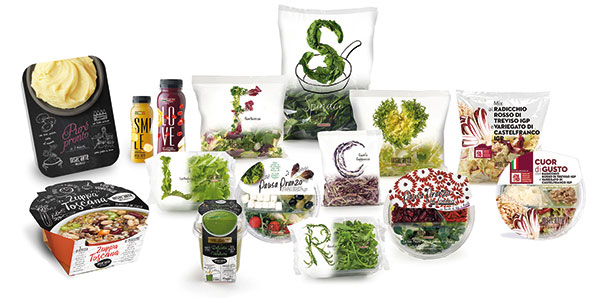4th and 5th range
Market and packaging of fresh fruit and vegetables: a growing and service-oriented sector. Plinio Iascone

4th and 5th range products include all fresh fruit and vegetables that are “barely treated” in order to guarantee safety, hygiene and quality through the application of good practices.
These ready-to-use products are washed, dried and packed in a sealed bag or container (sometimes using modified atmosphere). They can be consumed raw or cooked, depending on the product, without the consumer needing to make any additional preparation. Both 4th and 5th range goods fall under the category “fresh” in that the shelf life of these products does not exceed 7 days.
The market and the packaging
A brief account of the fresh produce sector is needed here. In 2016, the sector grew by 1% (in volume). This growth was driven by fruit (+3%), while vegetables remained largely stable.
The current year had a good start, as already in the early months the growth trend has held, according to Macfrut’s research office.
According to early estimates by Istituto Italiano Imballaggio on production in the sector, around 1,228 t/000 of 4th and 5th range products were marketed in 2016, compared to a total of some 12,660 t/000 of total fruit and vegetable products for end consumers (table 1).
The sector resumed a positive growth trend in 2015 after a consumption crisis that started in 2013 and affected all food sectors, including fresh fruit and vegetables. From 2011 to 2016, 4th and 5th range products saw average annual growth of approximately 7% (figure 1), and the trend should remain stable for the next 5 years.
4th and 5th range products should see steady growth because they satisfy consumer demand for easy to use yet fresh food, with intact nutritional and organoleptic properties and a longer shelf life than traditional fresh produce.
As for distribution, chain retailers remain the dominant channel, taking up a 79% share, followed by vending machines with a 14% share, largely made up of MAP solutions. The remainder is packed in PET or PS tubs. In recent years, the innovation in packaging for the sector has been represented by large formats; In fact, although the traditional formats (80 - 100 g) are the most common, the use of these products in large-scale catering, and especially in canteens, has meant that large formats (500 g and 1 kg ) have also been developed, both for vegetables that require cooking as well as for salads. The trend particularly concerns flexible laminated pouches and plastic trays.
Another element to highlight is the introduction in the packaging of cutlery and condiments in separate sachets (mostly for salads and fruit salads).
In the coming years an ever greater diffusion of plastic trays and trays in PS is assumed for fresh cut convenience produce, thanks to the increase in popularity of this type of product.
Plinio Iascone
Istituto Italiano Imballaggio
|
Le 5 gamme dell’ortofrutta I gamma: ortofrutta fresca tradizionale. II gamma: ortofrutta e verdure in conserva proposte in barattolo. III gamma: frutta e verdure surgelate. IV gamma: ortofrutta fresca, lavata, confezionata e pronta al consumo. V gamma: frutta e verdure cotte e ricettate, confezionate e pronte al consumo. |
Plinio Iascone
Istituto Italiano Imballaggio



















